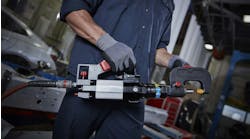The practice of MIG Brazing has been in use for a long time. Developed in the late 1960s, it immediately found applications in the automotive industry, primarily cosmetic at first. With this long history, why is there so much discussion about it now? Like aluminum, the renewed interest is due to new applications and increased usage. Manufacturers like Honda, Chrysler, JLR, Toyota and Mercedes-Benz all have repair procedures calling for MIG brazing. As the use of silicon bronze increases, it is important for technicians to be aware of the differences between welding and MIG brazing regarding materials, process, equipment and technique.
Materials
So first let’s look at the material. Copper is combined with other elements, such as tin, silicon or aluminum, to create bronze. The added components give the alloy strength, ductility, corrosion resistance, etc. In the automotive industry we primarily use the silicon-based alloy, referred to as silicon bronze. You may also see it referred to as CuSi3 or the AWS designation of ER CuSi-A.
In North America, we tend to refer to all wire-fed welding as MIG welding, when in actuality most of it is MAG welding. The difference is in the type of shielding gas used — Metal Active Gas (MAG) or Metal Inert Gas (MIG). The CO2 or CO2/argon mix gas used with steel is an active gas. The CO2 reacts to the arc releasing oxygen. Inert gases do not breakdown during the weld process. As the name suggests, MIG brazing uses an inert gas — 100 percent argon. Having the correct type of gas and proper flow rate are critical to protecting the weld and the stability of the arc. The typical flow rate is 25 CFH. It is important to verify that the gas regulator (flow gauge) has a separate scale for argon (Ar).
Process
The main distinction between welding and brazing is that MIG brazing is adhesion, not fusion. By definition, welding is the process of bringing the base pieces to a molten state where they are combined or fused, often with a filler material. In MIG brazing, the base material remains intact; it does not melt. Instead, the silicon bronze melts, flowing around and between the base pieces to create the joint. This is possible because silicon bronze melts at approximately 1940° F. By comparison, MIG/MAG welding generates temperatures in excess of 3000° F. This dramatic difference in temperature is one of the biggest benefits of MIG brazing and what makes it ideal for new vehicle construction. Even though bronze is softer than steel, with the proper technique, the repair has a tensile strength very close to that of a steel MAG weld.
Equipment
Silicon bronze being softer than steel filler wire is a great benefit when dressing the weld. However, it does mean the wire feed system needs to be set up to handle it. Using a wire feed system set up for steel causes friction and drag on the wire, which affects the consistency of the arc. Instead, wire liners made of Teflon, plastic, or carbon cut down on friction and are therefore ideal for silicon bronze. U-shaped feed wheels offer another benefit. The U-shaped grooves make more contact with the bronze wire and are less likely than standard V-shaped or flat wheels to damage it. As long as the wire diameters are the same, silicon bronze will run with the same wire feed setup as aluminum. There is no risk of cross contamination, like there is between aluminum and steel.
The biggest difference in equipment lies in the spray pulse capabilities. Normal MAG steel welding uses short-circuit metal transfer, or dip transfer, meaning the wire extends out until it comes in contact with the work piece. The contact, or short circuit, causes the current to peak and the end of the wire melts off in the weld pool. By contrast, spray pulse uses a lower background current to establish and maintain the arc. The amperage is then briefly increased — pulsed — providing enough heat to melt the tip of the wire. The droplet that is formed is then propelled across the arc to the weld. The filler wire and the work piece never touch.
MIG brazing can be done with either short circuit or spray pulse transfer. With spray pulse, the average of the background and pulse currents is less than the current produced when the wire shorts to the work piece. Less current means less heat, less distortion of thin materials, and less galvanized coating to burn off. Also, when used to join advanced high-strength steels (AHSS), it prevents damage to the integrity of the metal. To optimize the spray pulse, and simplify setting the welder, most pulse welders are synergic inverter welders. “Synergic” means that the relationship between all of the parameters are already built into the welder. When the technician sets the material thickness, the machine establishes the starting voltage, amperage and wire speed. The pulse also serves to control the bead characteristics by transferring one droplet per pulse.
Technique
The technique used for MIG brazing is very similar to MIG welding aluminum. You want to push the weld rather than pull it. That way any coatings that are burnt off will be expelled in front of the weld and not get trapped in the weld pool. This also preheats the metal, encouraging flow. The torch angle is more perpendicular to the work piece than with steel, about 75° - 80°.
As with any repair, proper preparation is essential. With silicon bronze you have the added concern with the root gap between the pieces. The process uses capillary action to flow between the work pieces. Looking at an open butt joint it is easy to understand how, with the proper root gap, it allows the bronze to flow through to the backside of the joint and form a bead there. But the same is true in a lap and all of the other joints. Done correctly, the bronze flows between the sheets regardless of weld position. Be aware that excessive clamping can limit the flow. Making sure the work pieces are clean also helps ensure proper flow or “wetting.”
Application
All of that brings us back to the question of what is driving the renewed interest in MIG brazing. OEMs have been using silicon bronze in production for years. Consider the 2008 Cadillac CTS with its laser-brazed roof, or the sail panel on the Dodge Intrepid. While used in production, there were virtually no repair procedures calling for brazing. As the push for fuel economy continues, one of the options is to build vehicle using harder, lighter steels. Creating these ultra-high strength steels involves controlled heating and cooling of the metal, trapping extra carbon in the molecular structure, which results in higher tensile strengths. The challenge is that if these materials are heated, during cooling the carbon can leech out, changing the properties of the steel back to HSS or even mild steel; see figure X. With squeeze-type resistance spot welding (STRSW), the electrodes hold the nugget under pressure following the weld, which helps draw some of the heat out of the metal. With MIG/MAG welding, there is not that option to quickly cool the steel. Instead, by using silicon bronze at its lower melting point, the joint can be made without damaging the integrity of the steel.
The 2016 Honda Pilot is a perfect example of a successful application of MIG brazing. The Pilot’s door outer stiffener ring is an assembly made of 1500 MPa steel, which must be replaced as a unit. An approved STRSW welder, manually set to Honda’s parameters, can be used to attach panels to the ring. In areas the welder cannot access, the spot welds are replaced with silicon bronze plugs. The repair procedure specifies either a single- or double-bronze plug braze, depending on the strength of the materials. The double-hole braze is made by placing two 8mm holes on 10mm centers. The result leaves a 2mm gap between the holes. The MIG braze must be done in pulse mode to control the heat and using a specific method. Beginning 5mm away from the hole, follow a tight zig-zag pattern across both holes and beyond. This technique encourages capillary action around and between the two holes. Tying the two holes together along with the large surface area provides the silicon bronze joint its strength. Single-hole plugs use the zig-zag method as well.
The Jaguar XF is another example of this application. JLR is requiring MIG brazing when attaching outer panels to the high-strength (HSS) or ultra-high-strength steel (UHSS) inner structure. They use a combination of 8mm x 20mm slots and open butt joints. Pulse mode is also required.
Another benefit of silicon bronze having a lower melting temperature is in corrosion resistance. The zinc in galvanized coatings melts at 788° F and evaporates at about 1670°. The heat at and extending out from a traditional steel weld (MAG) destroys much of the protection. With silicon bronze, particularly in pulse mode, the zinc remains intact except for a small amount right at the joint. Over time the zinc will flow back, making the entire repair corrosion resistant again.
Just as the use of UHSS continues to increase, so will the need for MIG brazing. As always, refer to the OEM repair procedures and use silicon bronze only where and when instructed. Get the right equipment and training now so you are ready.




